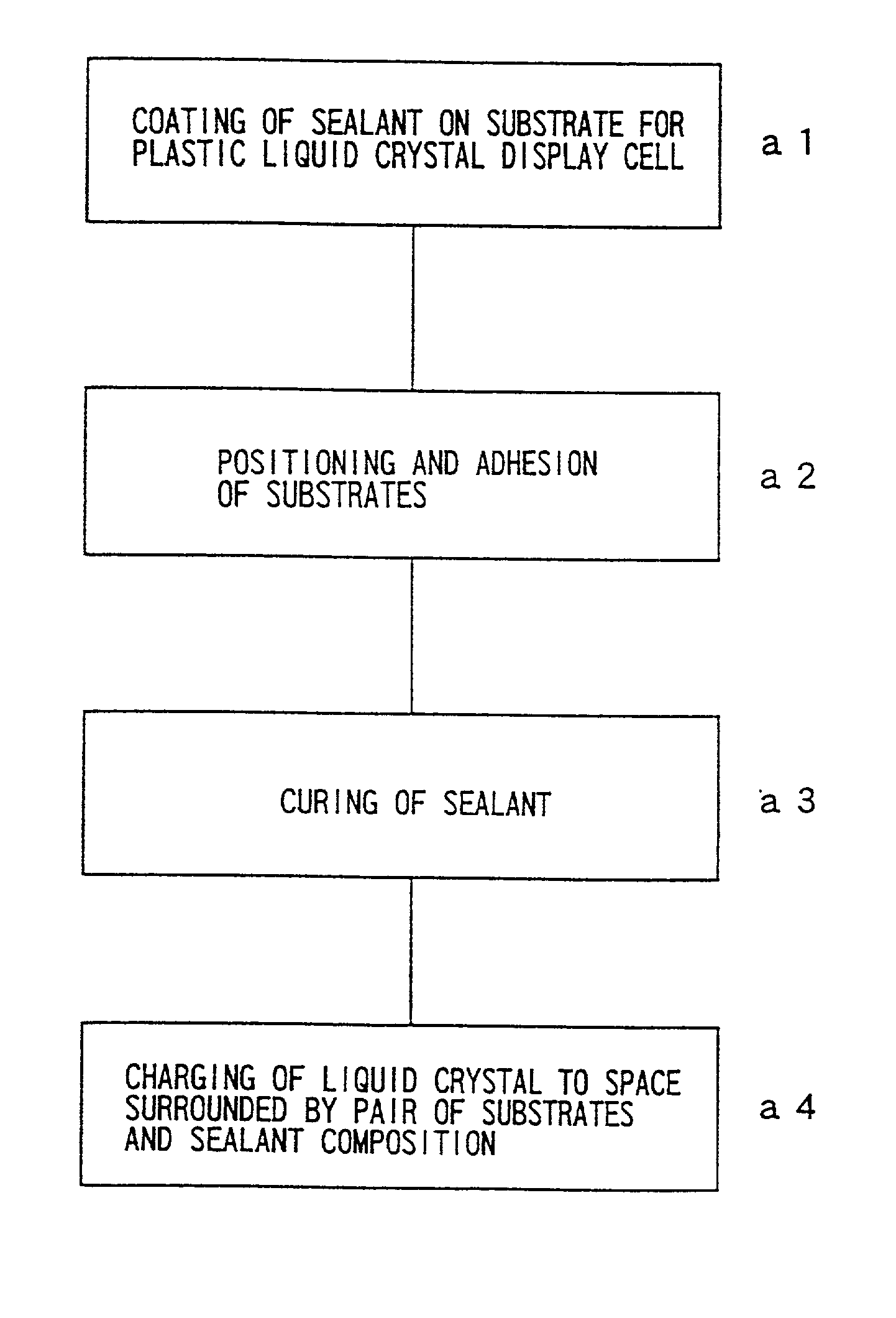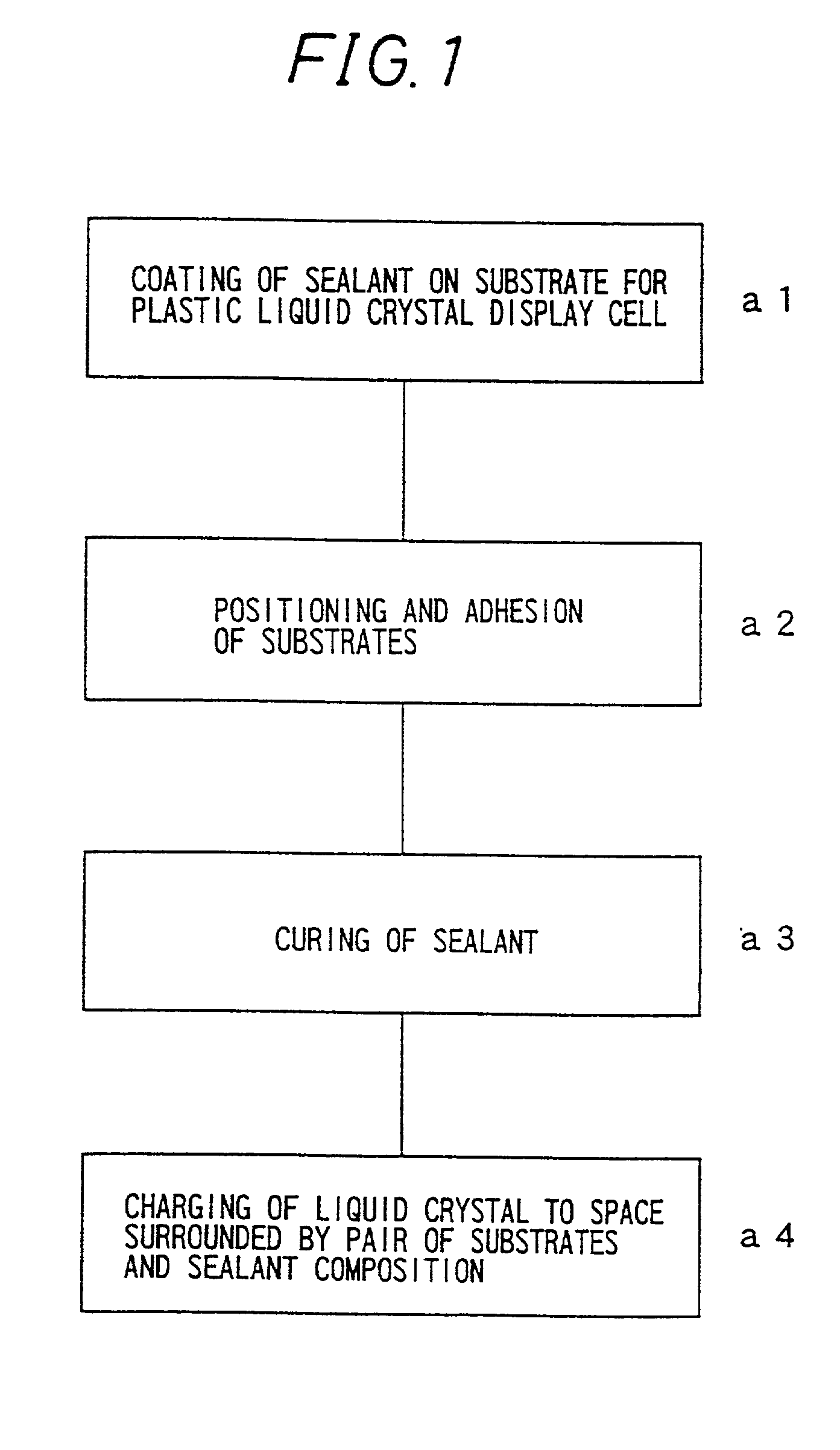Sealing material for plastic liquid crystal display cells
a liquid crystal display cell and adhesive technology, applied in the direction of adhesive types, instruments, transportation and packaging, etc., can solve the problems of uneven display, decreased response speed and the like, and liquid crystal display cell functional disorder
- Summary
- Abstract
- Description
- Claims
- Application Information
AI Technical Summary
Benefits of technology
Problems solved by technology
Method used
Image
Examples
synthesis example 1
[0411] Synthesis of epoxy resin composition (a) containing rubbery polymer fine particles (micro-crosslinking acrylic rubber fine particles, abbreviated as S1)
[0412] 500 g of Epiclon 830S and 100 g of Adeka EP4000S as the bifunctional epoxy resin, 10 g of methacrylic acid, 0.1 g of triethanolamine and 50 g of toluene were placed in a 2,000-ml four-neck flask equipped with a stirrer, a gas inlet tube, a thermometer and a condenser tube, and reaction was carried at 110.degree. C. for 5 hours under introduction of the air to introduce double bonds. 350 g of butyl acrylate, 20 g of glycidyl methacrylate, 1 g of divinylbenzene, 1 g of azobisdimethylvaleronitrile and 2 g of azobisisobutyronitrile were then added thereto, and reaction was carried out under introduction of nitrogen at 70.degree. C. for 3 hours and then at 90.degree. C. for 1 hour.
[0413] Toluene was then removed at 110.degree. C. under reduced pressure to obtain an epoxy resin composition (a).
[0414] A part of the epoxy resin...
synthesis example 2
[0416] Synthesis of epoxy resin composition (b) containing rubbery polymer fine particles (micro-crosslinking acrylic rubber fine particles, abbreviated as S2).
[0417] 604 g of Adeka EP4023S as the bifunctional epoxy resin, 6 g of methacrylic acid, 0.2 g of triethanolamine and 50 g of toluene were placed in a 2, 000-ml four-neck flask equipped with a stirrer, a gas inlet tube, a thermometer and a condenser tube, and reaction was carried at 110.degree. C. for 5 hours under introduction of the air to introduce double bonds.
[0418] 350 g of 2-ethylhexyl acrylate, 20 g of glycidyl methacrylate, 1 g of 1,6-hexanediol dimethacrylate, 1 g of azobisdimethylvaleronitrile and 2 g of azobisisobutyronitrile were then added thereto, and reaction was carried out under introduction of nitrogen at 70.degree. C. for 3 hours and then at 90.degree. C. for 1 hour.
[0419] Toluene was then removed at 110.degree. C. under reduced pressure to obtain an epoxy resin composition (b).
[0420] A part of the epoxy re...
example 1
[0422] 56 parts of the epoxy resin composition (a), 24 parts of Epiclon 830S, 14.5 parts of the bariumsulfate fine particles, 3 parts of MU-120, 2.4 parts of KBM-403, 0.09 part of the dimethylamine adduct of tolylene diisocyanate and 0.01 part of DBU octylic acid salt were preliminarily mixed in a Dalton mixer. They were then kneaded with three-roll made of ceramics until the solid raw materials became 5 .mu.m or less, and the kneaded product was subjected to a vacuum defoaming treatment to obtain a base resin liquid (P1 base resin liquid) for a two-component sealant composition for a plastic liquid crystal display cell P1.
[0423] Separately, a composition of 76 parts of pentaerythritol tetrakis(3-mercaptopropionate) and 24 parts of the barium sulfate fine particles was preliminarily mixed in a Dalton mixer. They were then kneaded with three-roll made of ceramics until the solid raw materials became 5 .mu.m or less, and the kneaded product was subjected to a vacuum defoaming treatmen...
PUM
| Property | Measurement | Unit |
|---|---|---|
| Temperature | aaaaa | aaaaa |
| Temperature | aaaaa | aaaaa |
| Linear density | aaaaa | aaaaa |
Abstract
Description
Claims
Application Information
 Login to View More
Login to View More - R&D
- Intellectual Property
- Life Sciences
- Materials
- Tech Scout
- Unparalleled Data Quality
- Higher Quality Content
- 60% Fewer Hallucinations
Browse by: Latest US Patents, China's latest patents, Technical Efficacy Thesaurus, Application Domain, Technology Topic, Popular Technical Reports.
© 2025 PatSnap. All rights reserved.Legal|Privacy policy|Modern Slavery Act Transparency Statement|Sitemap|About US| Contact US: help@patsnap.com


